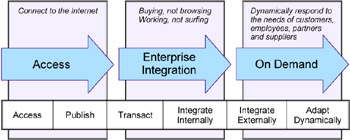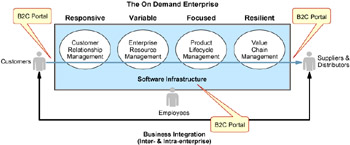2.3 Portals and e-business on demand
|
| < Day Day Up > |
|
2.3 Portals and e-business on demand
As we have seen, portals have been around for years and are likely to remain for the foreseeable future. It appears that e-business is heading towards what IBM terms "the era of e-business on demand." This section describes where portals fit into on demand and explains how they can help lead an e-business in that direction.
2.3.1 What is an e-business on demand?
IBM defines this as one whose leaders can see and manage their company as an integrated whole.
Throughout the business, previously isolated departmental operations must be transformed into business processes integrated across the company and in the way they are viewed by its customers.
An on demand business has four essential characteristics:
-
Responsive— Intuitively responsive to dynamic, unpredictable changes in demand, supply, pricing, labor, and competition
-
Variable— Flexible in adapting to variable cost structures and processes associated with productivity, capital, and finance
-
Focused— Concentrated on core competency, differentiated tasks, and assets, with tightly integrated strategic partners
-
Resilient— Capable of managing changes and threats with consistent availability and security
To attain these characteristics, companies need an operational environment that ties their business processes together.
2.3.2 Building the on demand operating environment
Integration and connectivity to this extent are accomplished through what IBM calls the on demand operating environment. This has four characteristics:
-
Integrated— Far more than simply connecting disparate computing resources, the on demand environment must enable the integration of core processes and systems so that business can flow inside companies and across multiple enterprises.
-
Open— As the basis for integration, open technical interfaces, and agreed-upon standards are essential.
-
Virtualized— Through an interconnected consolidation of computing infrastructure, grid computing will allow distributed computing resources to be shared and managed as a single, large, virtual computer.
-
Autonomic— Similar to the way the human autonomic system manages our vital functions, the enormous complexity of tomorrow's computing systems must rely on technology that manages itself.
The benefits of an on demand operating environment are enormous. Because business applications can be integrated according to open standards, it facilitates system interoperability; and as businesses prepare their internal systems to support processes across the company, they can take advantage of a growing virtualized grid of computing resources that allows them to reach more customers farther and faster. Finally, the complexity of these systems will be managed autonomically, thus relieving much of the human-intensive activity traditionally associated with large-scale business computing.
2.3.3 The evolution of e-business on demand
An e-business on demand evolves in phases. In each phase, the Internet transforms the business processes.
-
Access to digital information—This phase is all about publishing content, mostly of the static "look-up" variety. Simple database queries allow us to check a bank account, check airline flight information, or see where our overnight package is. It's pretty easy to get in the game here. All an enterprise needs is a home page, and all the user needs is a browser.
-
Real transactions, real e-business—Don't just look at your bank account—move some money. Don't just check a flight departure time—book your seat. Trade a stock, buy a book, apply for a loan, renew your driver's license, take a college course. Doing this requires more than a Web site—it requires behind-the-scenes integration of technologies and business processes.
-
The advanced stage of e-business—In a fluid system of customers, suppliers, partners, and employees, the Internet is the primary way to communicate, transact, and connect. Business processes shift from manual to automated. A relationship could last only as long as a single transaction. The environment is real time computing. Here we form networked communities so that organizations can:
-
Create new products and services faster
-
Reach new customers and add new relationships economically
-
Dynamically change existing relationships
-
Simultaneously engage in multiple e-business models
-
Improve access to information by constituents involved in these relationships
-

Figure 2-8: Steps required to become an e-business on demand
What's the return on investment for an enterprise that progresses through these phases? An increased share of customer spending, a better return on assets, new revenue opportunities, and better shareholder return.
Every industry segment has the common requirement to integrate end-to-end so that products, government and private sector services, invoices, images, decisions, and answers are all available on demand. Who will have the competitive advantage? The enterprises that get there first, with the software and service providers that know how to make it happen.
Any globally connected enterprise must have the ability to handle whatever comes its way, including changes in customer preferences or competitive actions, fluctuations in capital markets, labor situations, natural disasters, or political unrest. An advanced e-business must be able to respond to the unpredictable and the unforeseen and never question the ability of the infrastructure to deliver.
In order to achieve this vision of "on demand," cross-industry integration is necessary. Industry consortiums, open source communities, and standards bodies are busy forging the common language, constructs, and protocols that will be used. Companies have spent billions on existing IT infrastructure, and they need to leverage its power. They must be able both to extend and customize existing applications and to build and deploy new applications more quickly than ever before.
| Which phase is your business in? |
|
2.3.4 How portals can lead to an e-business on demand
In the on demand world, business needs change more rapidly than in traditional models. As business conditions change, new opportunities will emerge and new threats will appear. In order to respond effectively, a company must be able to:
-
Assimilate information quickly and make rapid decisions
-
Reform existing applications and create new ones in the blink of an eye
-
Target specific users with focused information, products, and services
This is the type of world where portals excel!
Portals enable a business to be responsive and variable
Portals by their very definition are accessible at any time from anywhere and on demand, with the ability to aggregate and display all relevant information. This puts the portal in a powerful position to enable people to make decisions quickly and effectively.
Businesses must be able to modify both their internal and external applications in the shortest possible time. Portals are specifically designed to be "snapped together" easily. This allows existing portals to be quickly reformed. With hundreds of off-the-shelf portlets now available, new portals can be quickly created and deployed, on demand.
Portals provide focus
Portals can be tailored to target a particular group of users, with very specific information and services allowing the business to focus its attention where it makes the most sense.
Portals are resilient
In the face of availability and security concerns, portals can help a business become resilient. Since portals are fundamentally constructed from components, [7] this provides the portal with a high degree of scalability and deployment flexibility. Portals also give the user a single point of access that can be made highly secure.
Portals enable integration
Portals (more specifically, the B2E variety) are considered a user-role integration vehicle because they facilitate a role-centric application paradigm. In this model employees are divided up into subgroups based on the roles they play. By identifying the primary functions of a particular role, interactions with a particular business process can be easily addressed. In this way the portal eases the burden of business process integration by enabling a role-centric approach. The B2E portal is then used to allow all employees to have personalized access (based on role) to relevant, up-to-date business content through the same user interface. An integrated interface and resulting user experience can actually ease back-end integration pains by "buying time" until strategic integration plans can be executed.
Portals are open
Enterprise-level portal infrastructures such as IBM's WebSphere Portal Server are built using standards-based technologies such as J2EE and Java. Standards such as SOAP [8] and the soon-to-be JSR 168 [9] focus on interoperability between portals and data sources.
2.3.5 Portals in an on demand operating environment
The most common types of business applications used by today's companies drive a variety of management capabilities—including CRM, ERM, [10] PLM, [11] and VCM. [12] These remain valuable resources. However, in the on demand era, these applications are not only integrated end-to-end across the company—they are also integrated with key suppliers and/or distributors outside the company, ultimately delivering greater business value to customers.

Figure 2-9: The on demand enterprise
[7]For example, portlets, Web services, and applications
[8]Simple Object Access Protocol
[9]JSR stands for Java Specification Request
[10]Enterprise Resource Management
[11]Product Lifecycle Management
[12]Value Chain Management
|
| < Day Day Up > |
|
EAN: 2147483647
Pages: 82